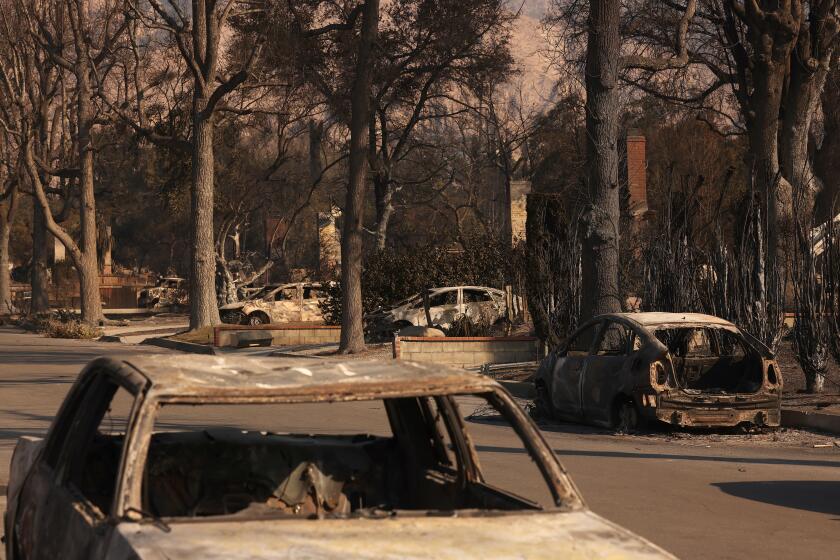In Altadena, a community wrestles with its future: Stay and rebuild, or move on?

- Share via
Miles Loudermilk’s family home survived the Eaton fire. But the neighborhood he grew up in was destroyed. The smell of toxic smoke has lingered in Altadena and homes still standing on West Terrace Street have been boarded up as residents stay away.
His parents are in their 70s; they never considered moving. But a month after a fire tore through their town, Loudermilk’s family and other residents have found themselves at a crossroads over whether to stay and rebuild their community, or leave.
“The landscape around the area is just decimated. We don’t know if that’s going to be looking that way for the next two or three, four, five, 10 years,” Loudermilk, 54, said.
“Altadena is not for sale” has become a rallying cry throughout neighborhoods. A growing number of yard signs dot the burned area where a rich tapestry of homes once stood. The unincorporated community’s eclecticism was a draw for many. Now on many blocks, all that’s left of the town’s history are the trees.
“Everyone loved Altadena in his or her own way, but the wildness of it and the freedom of it is something that is deeply important to people,” said Hans Allhoff, the chair of Altadena Heritage. “I think there is a concern that with a heavily supervised, regulated rebuild, we’ll lose some of that.”
The Eaton fire destroyed thousands of structures in Altadena and Pasadena. Now, residents grapple with how they can afford to rebuild.
Allhoff lost his home on Sunny Oaks Circle in the fire and has remained evacuated. He understands that people have to make decisions that are best for them; he also hopes the community can slow down and work together to develop a plan to move forward.
Listings have emerged in recent days for land that burned in the fire. At least one property has been sold. Residents fear that if much of the community does not band together and commit to returning, or to ensure that vacated properties go to people who will preserve the sanctity of the town, Altadena could reemerge unrecognizable not just in look but in spirit.
Before the fire, roughly 42,000 people lived in Altadena. The foothill town served as an enclave for artists and independent thinkers who preferred the small-town feel over the hustle of other parts of the county — it wasn’t uncommon for people to own chickens or horses, with easy access to hiking trails and mountain views. Nearly 10,500 residents lived and worked in Altadena, where many businesses were locally-run fixtures in the community.
Families planted multigenerational roots, including in historical Black neighborhoods on the Westside.
Joe Kilanowski, a resident of Altadena and a board member for Pasadena Heritage, said it will take disparate interests to ensure that all parts of the community are represented in a new vision.
“How do you rebuild a community like that? It’s not going to be done by people who want to build a homogeneous, monotonous world,” he said.
On a recent rainy night, Loudermilk brought his parents to a town hall in the hopes of learning more about where the community stood on the matter. Alongside hundreds of others who gathered inside La Cañada Congregational Church, they sought answers — and inspiration.
“They’re just trying to get some reassurance that Altadena will survive — and it’s not going to be taken over by a big development firm,” Loudermilk said about his parents’ dilemma.

Freddy Sayegh organized the event. His parents’ home on Gaywood Drive, where he grew up, burned down in the fire. It had been a central meeting place for his family; they had just celebrated Christmas together.
The sight of what’s left hurts.
“It always catches my breath when I come here. It’s easier to talk in La Cañada or somewhere else,” Sayegh, 51, said, while standing in the rubble of a bedroom. “I rolled down as a 5-year-old and scraped my knees here … When my children were born, they huddled in this house. When my grandparents died, they huddled in this house. The funerals, the gatherings — this was the center of our community.”
While his own house on Sonoma Drive survived, he has remained evacuated. He is committed to returning and has made it a mission to unify the community, but he knows a rebuild won’t be easy.
“Everybody says, ‘Thank God your house is still standing.’ But what does that mean? When every school, every church is gone?” Sayegh said. “Every time I leave my house, I’m going to see the devastation.”
The Eaton fire cut a brutal swath through Altadena and a cherished way of life in this eclectic foothill community it upended.
At the townhall meeting, representatives from FEMA and the Small Business Administration tried to reassure residents that resources were available to help them rebuild if they chose to. FEMA encouraged residents to apply for assistance even if insurance provided help and SBA said that despite its name, it also helps homeowners. Experts on real estate and insurance told residents to take time in deciding what to do next — they shouldn’t feel pressured to sell.
Leslie Aitken, a 49-year resident of Altadena who runs a community Facebook page that is followed by thousands, lost her home in the fire. While she hopes Altadena will rebuild, she made a plea on behalf of senior residents who might want to leave in the end.
“Be gentle with us. Because we don’t have maybe another 15 years looking in front of us. We have most of our years in Altadena behind us and some of us are going to have to make some really hard decisions,” she said. More than 21% of the residents are 65 or older, according to the U.S. Census. That is more than the national average, which is less than 18%.
“Don’t make them a pariah.”

Since the fire, neighbors Lark Crable, 72, and Sophia Newton-Welcome, 38, said they have been bombarded with calls and messages from real estate agents asking if they were interested in selling their properties. They have remained steadfast in returning to their homes — just a few that survived on their street — but they know others will decide differently.
“I have a place to move back to. But all of my friends don’t,” Crable said at a recent Altadena Not For Sale rally. “I have friends who say they’re going to sell. It’s too much for them — they can’t do it.”
Heavenly Hughes, 49, helped organize the rally. Her family’s house on Altadena Drive survived the fire, but she said it will likely have to be gutted after smoke damage. She said her family remains evacuated, possibly for 18 months, but plans to return.
Hughes’ nonprofit My Tribe Rise is a mutual aid organization focused on the Black community. She is trying to reach residents who are unsure if their future will be tied to the town and believes that the community must take action together to protect Altadena’s future.
“We want to be sure that the officials, the county supervisors, the governor — those who are making decisions for our Altadena — make sure that we’re in the forefront of that messaging and in that action,” Hughes said. “We know the Altadena that we were raised in, that we developed, that we created here is no more, as far as a visual. But we are the community, we are the culture of Altadena, we are the people of Altadena. And we’re not going to get erased.”
The Altadena fire wiped out much of a historic Black enclave in this picturesque town in the San Gabriel Valley.
L.A. County Supervisor Kathryn Barger, who oversees Altadena, has introduced a commission to focus on recovery efforts. Gov. Gavin Newsom has signed more than $2.5 billion in disaster relief benefits for communities affected by the wildfires here and in Pacific Palisades, and leaders such as Rep. Judy Chu (D-Monterey Park), whose district includes Altadena, have vowed assistance.
But residents worry that Los Angeles County’s other focuses around preparations for the 2028 Olympics and 2026 World Cup could sidestep priorities, or that the quaint community, whose local representation is a volunteer-run town council, will be overlooked at the federal level. Sayegh’s first town hall, for example, was rescheduled in anticipation of President Trump’s visit to California after the wildfires. But Trump never made it to Altadena — a decision that left residents fearing they will be forgotten.

At the town hall, Sayegh made a pitch for collective action: The community should form a coalition to rebuild. If they approached contractors as a group and sourced materials together, he believed they could save money and ensure a smoother path towards restoration.
“We must fight for each other because that’s all who’s going to care about us — our neighbors and you,” Sayegh said.
Steven Lamb was sold on Sayegh’s proposal. The designer lost his home in Altadena and has no intention of selling it — he’d rather declare his land a park than sell to a developer, he said. Lamb and others told Sayegh they were on board to lend their services and help.
Others were apprehensive. One woman who lost her home said she was overwhelmed by the road ahead and while she believes that the community needs to dream big, she is still assessing what makes sense for her.
Loudermilk was invigorated. This was the motivation he and his parents needed to move forward, and to imagine what a rebuilt community could become.
“I can see there’s going to be cohesiveness,” he said. “It’s just a lovable city and I don’t think people want to part with that.”
Before the meeting ended, singer Aloe Blacc, whose children lost their school in the fire, delivered a familiar song.
Lean on me, when you’re not strong.
I’ll be your friend.
I’ll help you carry on.
The crowd rang out in chorus.
More to Read
Sign up for Essential California
The most important California stories and recommendations in your inbox every morning.
You may occasionally receive promotional content from the Los Angeles Times.














